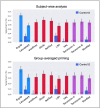This is a preprint.
The Primacy of Experience in Language Processing: Semantic Priming Is Driven Primarily by Experiential Similarity
- PMID: 36993310
- PMCID: PMC10055357
- DOI: 10.1101/2023.03.21.533703
The Primacy of Experience in Language Processing: Semantic Priming Is Driven Primarily by Experiential Similarity
Update in
-
The primacy of experience in language processing: Semantic priming is driven primarily by experiential similarity.Neuropsychologia. 2024 Aug 13;201:108939. doi: 10.1016/j.neuropsychologia.2024.108939. Epub 2024 Jun 18. Neuropsychologia. 2024. PMID: 38897450 Free PMC article.
Abstract
The organization of semantic memory, including memory for word meanings, has long been a central question in cognitive science. Although there is general agreement that word meaning representations must make contact with sensory-motor and affective experiences in a non-arbitrary fashion, the nature of this relationship remains controversial. One prominent view proposes that word meanings are represented directly in terms of their experiential content (i.e., sensory-motor and affective representations). Opponents of this view argue that the representation of word meanings reflects primarily taxonomic structure, that is, their relationships to natural categories. In addition, the recent success of language models based on word co-occurrence (i.e., distributional) information in emulating human linguistic behavior has led to proposals that this kind of information may play an important role in the representation of lexical concepts. We used a semantic priming paradigm designed for representational similarity analysis (RSA) to quantitatively assess how well each of these theories explains the representational similarity pattern for a large set of words. Crucially, we used partial correlation RSA to account for intercorrelations between model predictions, which allowed us to assess, for the first time, the unique effect of each model. Semantic priming was driven primarily by experiential similarity between prime and target, with no evidence of an independent effect of distributional or taxonomic similarity. Furthermore, only the experiential models accounted for unique variance in priming after partialling out explicit similarity ratings. These results support experiential accounts of semantic representation and indicate that, despite their good performance at some linguistic tasks, the distributional models evaluated here do not encode the same kind of information used by the human semantic system.
Keywords: Concept representation; Distributional semantics; Lexical decision; Lexical semantics; Semantic memory.
Figures






Similar articles
-
The primacy of experience in language processing: Semantic priming is driven primarily by experiential similarity.Neuropsychologia. 2024 Aug 13;201:108939. doi: 10.1016/j.neuropsychologia.2024.108939. Epub 2024 Jun 18. Neuropsychologia. 2024. PMID: 38897450 Free PMC article.
-
Distinct fronto-temporal substrates of distributional and taxonomic similarity among words: evidence from RSA of BOLD signals.Neuroimage. 2021 Jan 1;224:117408. doi: 10.1016/j.neuroimage.2020.117408. Epub 2020 Oct 10. Neuroimage. 2021. PMID: 33049407
-
A Distributed Network for Multimodal Experiential Representation of Concepts.J Neurosci. 2022 Sep 14;42(37):7121-7130. doi: 10.1523/JNEUROSCI.1243-21.2022. Epub 2022 Aug 8. J Neurosci. 2022. PMID: 35940877 Free PMC article.
-
The meaning of 'life' and other abstract words: Insights from neuropsychology.J Neuropsychol. 2016 Sep;10(2):317-43. doi: 10.1111/jnp.12065. Epub 2015 Feb 23. J Neuropsychol. 2016. PMID: 25708527 Free PMC article. Review.
-
Building semantic memory from embodied and distributional language experience.Wiley Interdiscip Rev Cogn Sci. 2021 Sep;12(5):e1555. doi: 10.1002/wcs.1555. Epub 2021 Feb 2. Wiley Interdiscip Rev Cogn Sci. 2021. PMID: 33533205 Review.
References
-
- Barsalou L. W., Santos A., Simmons W. K., & Wilson C. D. (2008). Language and Simulation in Conceptual Processing. In de Vega M., Glenberg A., & Graesser A. (Eds.), Symbols and embodiment: Debates on meaning and cognition (pp. 245–283). https://doi.org/ 10.1093/acprof:oso/9780199217274.003.0013 - DOI
Publication types
Grants and funding
LinkOut - more resources
Full Text Sources
